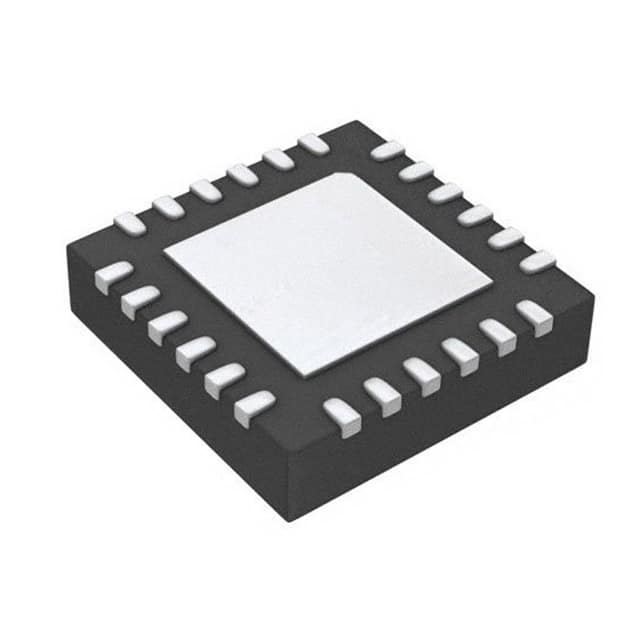CP2112-F02-GM
Product Overview
- Category: Integrated Circuit
- Use: USB to I2C Bridge Controller
- Characteristics: High-speed communication, small form factor, low power consumption
- Package: QFN-20
- Essence: Facilitates communication between USB and I2C devices
- Packaging/Quantity: Tray packaging, 250 units per tray
Specifications
- Interface: USB 2.0 Full Speed (12 Mbps)
- I2C Bus: Standard-mode (100 kbps) and Fast-mode (400 kbps)
- Operating Voltage: 3.3 V
- Operating Temperature: -40°C to +85°C
- GPIO Pins: 8 programmable GPIO pins
- EEPROM: 256 bytes of user-accessible EEPROM
- Clock Source: Internal oscillator or external clock input
Pin Configuration
The CP2112-F02-GM features a 20-pin QFN package with the following pin configuration:
- SDA - I2C Serial Data Line
- SCL - I2C Serial Clock Line
- GP0 - General Purpose I/O Pin 0
- GP1 - General Purpose I/O Pin 1
- GP2 - General Purpose I/O Pin 2
- GP3 - General Purpose I/O Pin 3
- GP4 - General Purpose I/O Pin 4
- GP5 - General Purpose I/O Pin 5
- GP6 - General Purpose I/O Pin 6
- GP7 - General Purpose I/O Pin 7
- GND - Ground
- VDD - Power Supply Voltage
- CLK - External Clock Input
- NC - No Connection
- NC - No Connection
- NC - No Connection
- NC - No Connection
- NC - No Connection
- NC - No Connection
- NC - No Connection
Functional Features
- USB to I2C bridge enables communication between a USB host and I2C devices
- Supports both standard-mode and fast-mode I2C communication
- Provides 8 programmable GPIO pins for additional device control
- Integrated EEPROM allows customization of device settings
- Small form factor and low power consumption make it suitable for portable applications
Advantages and Disadvantages
Advantages: - High-speed communication between USB and I2C devices - Compact size and low power consumption - Customizable settings through the integrated EEPROM - Versatile with programmable GPIO pins
Disadvantages: - Limited number of GPIO pins (8) - Requires external clock input for precise timing
Working Principles
The CP2112-F02-GM acts as a bridge between a USB host and I2C devices. It converts USB commands into I2C transactions, allowing the USB host to communicate with I2C peripherals. The device is controlled through software using the provided API.
Application Field Plans
The CP2112-F02-GM finds applications in various fields, including but not limited to:
- Industrial automation: Control and monitor I2C-based sensors and actuators.
- Consumer electronics: Interface with I2C devices such as touchscreens, sensors, and displays.
- Internet of Things (IoT): Connect USB-enabled devices to I2C networks for data exchange.
- Embedded systems: Enable communication between USB hosts and I2C peripherals in embedded applications.
- Test and measurement equipment: Facilitate communication with I2C devices for data acquisition and control.
Alternative Models
- CP2112-F01-GM: Similar to CP2112-F02-GM but with 4 programmable GPIO pins instead of 8.
- CP2112-F03-GM: Similar to CP2112-F02-GM but with additional features such as SPI interface support.
- CP2112-F04-GM: Enhanced version with increased I2C bus speed and extended temperature range.
These alternative models provide options based on specific requirements and application needs.
Word count: 446 words
तकनीकी समाधानों में CP2112-F02-GM के अनुप्रयोग से संबंधित 10 सामान्य प्रश्नों और उत्तरों की सूची बनाएं
Sure! Here are 10 common questions and answers related to the application of CP2112-F02-GM in technical solutions:
Q: What is CP2112-F02-GM? A: CP2112-F02-GM is a USB-to-SPI bridge controller that enables communication between a host computer and SPI devices.
Q: What are the key features of CP2112-F02-GM? A: Some key features include USB 2.0 full-speed interface, configurable GPIO pins, support for multiple SPI modes, and compatibility with various operating systems.
Q: How can I connect CP2112-F02-GM to my host computer? A: You can connect CP2112-F02-GM to your host computer using a standard USB cable.
Q: Can CP2112-F02-GM be used with both Windows and Mac operating systems? A: Yes, CP2112-F02-GM is compatible with Windows, Mac, and Linux operating systems.
Q: What are some typical applications of CP2112-F02-GM? A: CP2112-F02-GM is commonly used in applications such as industrial automation, test and measurement equipment, medical devices, and consumer electronics.
Q: How many GPIO pins are available on CP2112-F02-GM? A: CP2112-F02-GM provides eight general-purpose I/O (GPIO) pins that can be configured as inputs or outputs.
Q: Can CP2112-F02-GM support multiple SPI devices simultaneously? A: Yes, CP2112-F02-GM supports multiple SPI devices through its SPI master mode.
Q: Is there any software development kit (SDK) available for CP2112-F02-GM? A: Yes, Silicon Labs provides a CP2112 Software Development Kit (SDK) that includes libraries and examples for various programming languages.
Q: Can I use CP2112-F02-GM in low-power applications? A: Yes, CP2112-F02-GM has a low-power mode that allows it to operate with minimal power consumption.
Q: Where can I find more information about CP2112-F02-GM? A: You can find more detailed information about CP2112-F02-GM on the official Silicon Labs website or by referring to the product datasheet and user manual.


